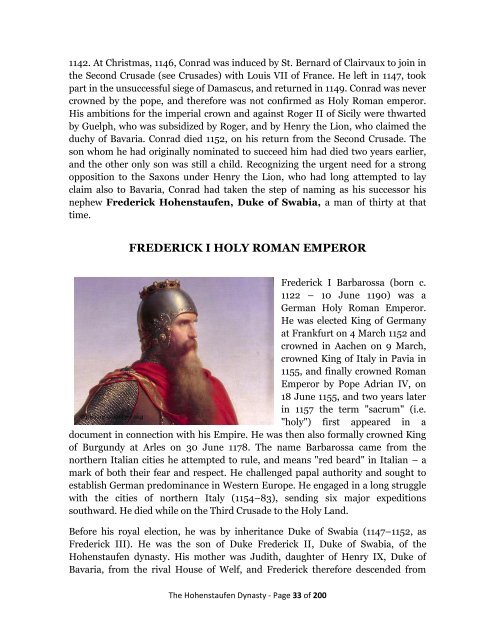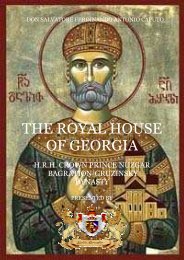here - Nobility Associations
here - Nobility Associations
here - Nobility Associations
You also want an ePaper? Increase the reach of your titles
YUMPU automatically turns print PDFs into web optimized ePapers that Google loves.
1142. At Christmas, 1146, Conrad was induced by St. Bernard of Clairvaux to join in<br />
the Second Crusade (see Crusades) with Louis VII of France. He left in 1147, took<br />
part in the unsuccessful siege of Damascus, and returned in 1149. Conrad was never<br />
crowned by the pope, and t<strong>here</strong>fore was not confirmed as Holy Roman emperor.<br />
His ambitions for the imperial crown and against Roger II of Sicily were thwarted<br />
by Guelph, who was subsidized by Roger, and by Henry the Lion, who claimed the<br />
duchy of Bavaria. Conrad died 1152, on his return from the Second Crusade. The<br />
son whom he had originally nominated to succeed him had died two years earlier,<br />
and the other only son was still a child. Recognizing the urgent need for a strong<br />
opposition to the Saxons under Henry the Lion, who had long attempted to lay<br />
claim also to Bavaria, Conrad had taken the step of naming as his successor his<br />
nephew Frederick Hohenstaufen, Duke of Swabia, a man of thirty at that<br />
time.<br />
FREDERICK I HOLY ROMAN EMPEROR<br />
Frederick I Barbarossa (born c.<br />
1122 – 10 June 1190) was a<br />
German Holy Roman Emperor.<br />
He was elected King of Germany<br />
at Frankfurt on 4 March 1152 and<br />
crowned in Aachen on 9 March,<br />
crowned King of Italy in Pavia in<br />
1155, and finally crowned Roman<br />
Emperor by Pope Adrian IV, on<br />
18 June 1155, and two years later<br />
in 1157 the term "sacrum" (i.e.<br />
"holy") first appeared in a<br />
document in connection with his Empire. He was then also formally crowned King<br />
of Burgundy at Arles on 30 June 1178. The name Barbarossa came from the<br />
northern Italian cities he attempted to rule, and means "red beard" in Italian – a<br />
mark of both their fear and respect. He challenged papal authority and sought to<br />
establish German predominance in Western Europe. He engaged in a long struggle<br />
with the cities of northern Italy (1154–83), sending six major expeditions<br />
southward. He died while on the Third Crusade to the Holy Land.<br />
Before his royal election, he was by inheritance Duke of Swabia (1147–1152, as<br />
Frederick III). He was the son of Duke Frederick II, Duke of Swabia, of the<br />
Hohenstaufen dynasty. His mother was Judith, daughter of Henry IX, Duke of<br />
Bavaria, from the rival House of Welf, and Frederick t<strong>here</strong>fore descended from<br />
The Hohenstaufen Dynasty - Page 33 of 200



